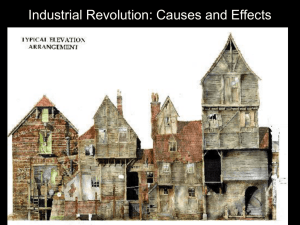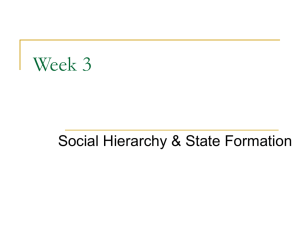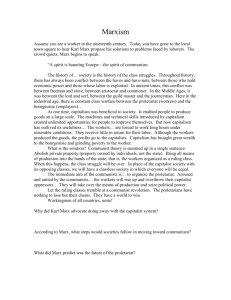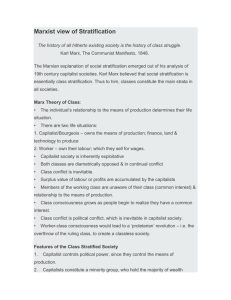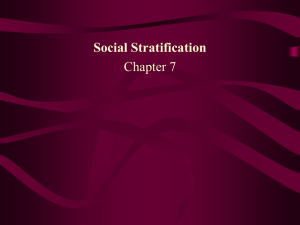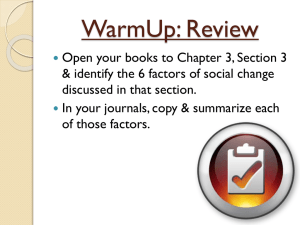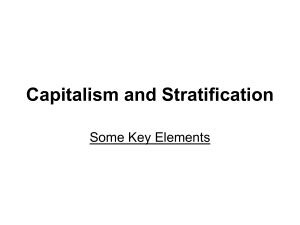333TheoreticalApproaches
advertisement
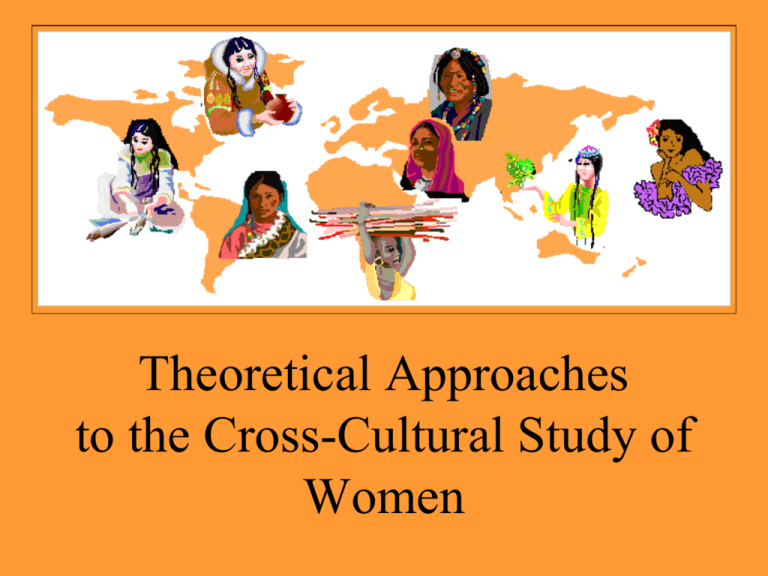
Theoretical Approaches to the Cross-Cultural Study of Women What is a Theory? Definition: a set of related hypotheses that provide a better explanation than any single hypothesis. You are using a theory if you are dealing with any of the following: • Definitions • Components of concepts • Relationships between concepts • Attempts to model how a system works • Explanations • Predictions Components of a Theory • Definitions for the central concepts used for explanation or prediction • Logical connections between concepts to create a system of explanation and/or prediction • Explanation and/or prediction • The development of assumptions that affect the way a problem or issue is viewed. The World of Theories • Theories can be based on logic, ideas or belief without the use of empirical evidence • Grounded theories are derived from empirical evidence, and are continuously tested against new empirical evidence • Many different and sometimes conflicting theories can coexist and be used for different purposes • Theories are the basis from which world views are developed and changed Theories about Gender • Theories about gender come from many disciplines including: Anthropology Biology Feminist and/or Women’s Studies Sociology Political Science Psychology • Theories from these disciplines have been shared and blended over the past 35 years. Classical Theorists Marx and Private Property • agricultural and urbanized societies produce a surplus Marx called private property. • the bourgeoisie is a class of individuals who control resources and accumulate surpluses as wealth. • the proletariat is the working class who provide the “social labor” through which resources become products. • the bourgeoisie controls the private property produced from resources and social labor in the form of wealth Classical Theorists Marx and Private Property Summary All societies organize themselves around the central struggle over the control of private property; the bourgeoisie fights to maintain their control and the proletariat fights to obtain control. This is “capitalism.” Eisenstein Revised Marx’s Theory of Private Property to better explain gender stratification. • Marx’s theory is not sufficient to explain why women do not rise as fast as men to status and wealth in the bourgeoisie. • Marx’s theory is not sufficient to explain why women’s social labor in the proletariat does not give them equal status with men. • The rise of capitalism must be combined with an ideology of patriarchy to fully explain gender stratification. Vogel Revised Marx’s Theory of Private Property to better explain gender stratification. • There are two modes aspects to production in capitalist societies: Production Reproduction of the mode of production (i.e. producing workers) • While labor is the key to producing a surplus, women will be controlled by men in order to control their offspring = gender stratification. • When reproduction of laborers is available from other sources (e.g. migrant laborers), then women do not need to be controlled. World Systems Theory Marxist-Inspired theory of global economics and gender stratification • The penetration of capitalism from Western Europe throughout the world has resulted in three types of societies: Core (e.g.United States, Japan, France) Semi-peripheral (e.g.Saudi Arabia, South Africa) Peripheral (e.g.African, Latin American nations) • Capitalist influence affects the social institutions and structures of societies in these categories differently. Ward Revised World Systems Theory to better explain gender stratification. The patriarchal nature and expectations of capitalism must be taken into consideration. • Core nations give control to men over resources, economic opportunities, educational and political institutions. • Women are confined to precapitalist subsistence farming and handicrafts that must compete with industrialized products • Access for women to participate in national and global capitalism is limited to labor in the “global assembly line” or low level service jobs. Classical Theorists Engels, Tylor and Morgan Tylor and Morgan developed a theory that explained the evolution of human culture in three stages: savagery, barbarism, and civilization. Engels expanded their theory in ways that explained the emergence of gender stratification using some of Marx’s principles. A Model of Engels’ Theory Karen Sacks Revised Engels’ theory to account for modern anthropological data. • Social labor is labor for use or appropriation by someone of another household. • Domestic work is labor done for one’s own household. • Doing social labor makes people “social adults.” • Those who do not do social labor are not considered social adults. Sacks . . . Con’t • Property ownership does not, as Engels proposed, constitute a sufficient cause for gender inequity. • The exclusion of women from social adulthood on the basis of their lack of social labor does. • As women increasingly contributed to social labor, their status as adults improved. • Ongoing responsibility for domestic work in addition to social labor results in the maintenance of lower social adulthood status for women. Rosaldo Maternally-based division of labor leads to gender stratification. • Women give birth to and nurse children • This leads to a universal division of labor between men and women • Women are in charge of activities that keep them close to home and are interruptible – the domestic sphere. • Men are in charge of activities that take them away from home for prolonged periods of time and cannot be interrupted – the public sphere. Rosaldo . . . Con’t • Women’s status is ascribed; Men’s status is achieved. • Women’s domestic roles are uniform and not hierarchically organized • Men’s public roles are socially constructed, and can be hierarchically organized. • The more separate the domestic sphere is from the public sphere, the less gender equality and the more male dominance. Weber Focused on ideology rather than material culture • Believed collective systems of thought (in our terms culture), especially religion, are the basis of social and economic institutions (eg. “the Protestant Ethic”) • Social status through symbols rather than economic class • Authority as opposed to power Power vs. Authority Power is the ability to make people do things Authority is the right given by society to make people do things Sanday Expanded on Weber’s approach in order to address gender stratification • Each culture has a “sex-role plan” that specifies how relationships between the sexes should be structured based on worldview and origin myths • There are two general types of sex- role plans: Inner orientation = forces of nature are sacred and associated with women (plant economies) Outer orientation = forces of nature are dangerous and must be controlled by men (animal economies) Sanday . . . Con’t • Male dominance is a response to stress from Technological complexity Migration Conflict with other societies Natural threats and dangers • Women will accept male dominance more easily in the context of male dominance in the myths and symbols of the society Ortner Nature vs culture and gender stratification • Women are seen as having a closer relationship with nature because they bear children. • Men are seen as having a closer relationship with culture, the means by which humans transcend and control nature. • Women create naturally; men must create artificially. • Women are close to nature, therefore they are part of what must be transcended and controlled • Women have less status in a cultural world. Classical Theorists Freud and Individuals All gender differences arise through developmental stages organized around sex Oral Stage – gratification through oral stimulation 0-2 Anal Stage – gratification through control of bowels 2-3 Phallic Stage – conflict over attraction to opposite sex parent (Oedipal and Electra Complexes) 3-5 Latent Stage – avoidance of opposite sex peers 5-12 Genital Stage – emergence of adult sexuality in teens 12+ A universal theory of human development. Classical Theorists Freud and The Origins of Culture • The first human group was a family with a father, a mother, sons and daughters. • The father had sole access to the mother for sex. • As they matured, the sons grew jealous and resentful of their father, because of his monopoly on sex. • The sons plotted to kill their father. They succeeded in killing and eating him, then taking over sexual access to their mother and sisters. • Eventually, they were overcome with guilt over what they had done to their father. They renounced sexual relations with mothers and sisters, establishing the first incest taboo, and the first real human culture that differentiated humans from animals. Kittay Neo-Freudian Variation Womb Envy leads to the need for men to control women and women’s fertility since they cannot bear children themselves (Menstruating men and Couvade) Couvade • From antiquity in Africa, China, Japan, India, Basques of France and Spain • South American groups such as the Caribs, the Arawakan, the Guayapo, and the Northwestern and Central GE of E Brazil, • The man mimics the pain and process of childbirth at the time his wife gives birth and may expect her to wait on him in the following days. Menstruating Men: Wogeo (Melanesia) • Men and women pollute one another when they come in contact. • Females automatically purge male contamination when they menstruate. Men must artificially bleed themselves to purge female contamination. Men are not required to menstruate every month. • Blood lost due in menstruation in both sexes is considered polluted and is not to be touched. To menstruate, the male: • eats nothing the morning of his menstruation • wades out to knee-high waters in the ocean • uses a crayfish or crab claw to cut the glans of the penis • Keeps the blood from touching his body. • goes to the men’s house when the cut stops bleeding • remains secluded for two or three days. Mead’s Symbolic Interactionism A developmental theory based on social learning through communication of roles Three stages: Play Stage– imitation of simplified roles observed in adults Game Stage – participation in complex games that simulate life Mature participation – ability to act out roles of others in real life settings Social Learning Theory • Learning through modeling the behavior of others using either Direct learning Vicarious learning • Process influenced by rewards and punishments meted out by others
